The Impacts of Macroeconomic Variables on Economic Growth
VerifiedAdded on 2023/06/03
|9
|2134
|289
AI Summary
This article discusses the impacts of macroeconomic variables such as GDP, inflation, wages, national savings, and aggregate expenditure on economic growth. It analyzes recent articles on each variable and provides a summary and analysis of their impact on the economy.
Contribute Materials
Your contribution can guide someone’s learning journey. Share your
documents today.
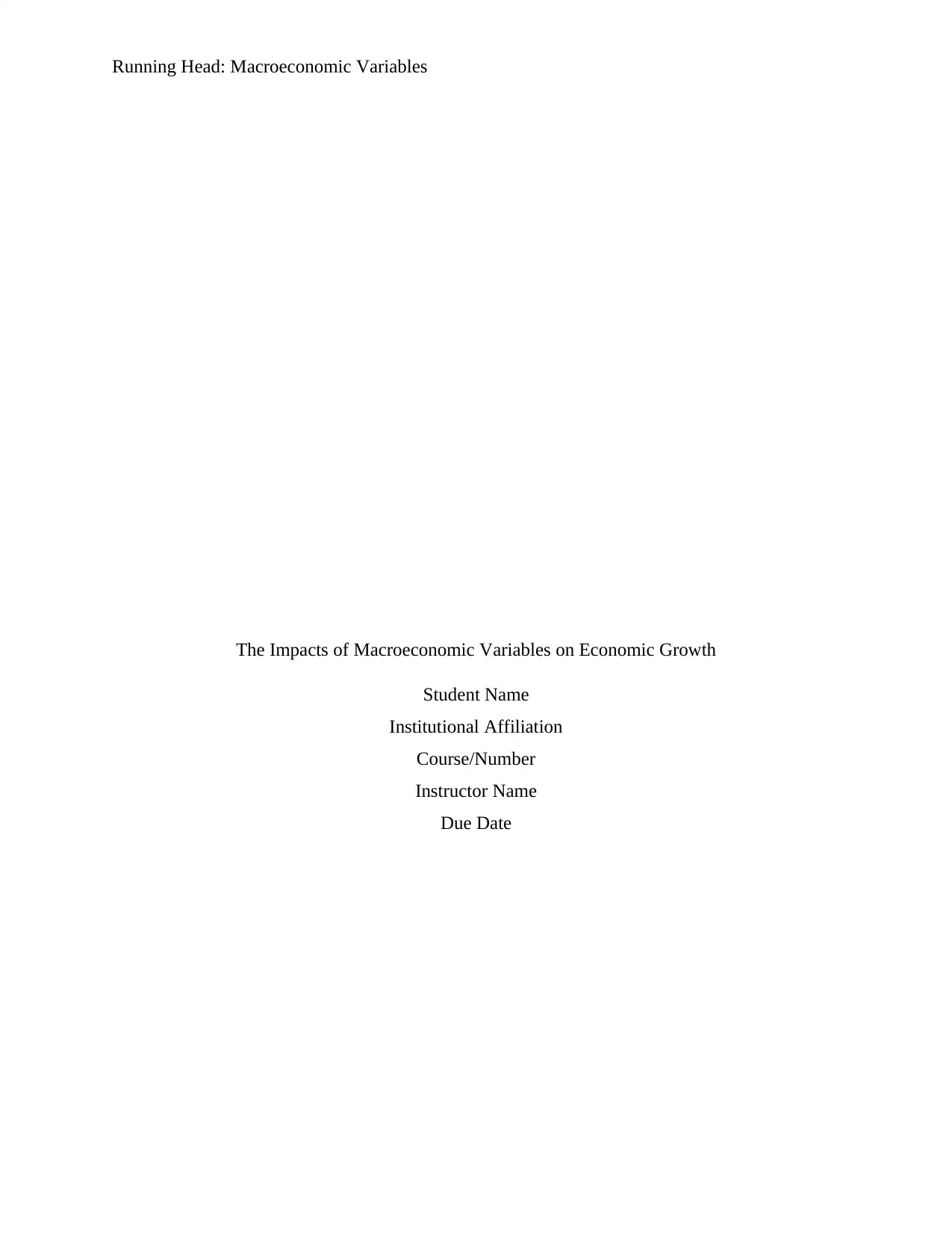
Running Head: Macroeconomic Variables
The Impacts of Macroeconomic Variables on Economic Growth
Student Name
Institutional Affiliation
Course/Number
Instructor Name
Due Date
The Impacts of Macroeconomic Variables on Economic Growth
Student Name
Institutional Affiliation
Course/Number
Instructor Name
Due Date
Secure Best Marks with AI Grader
Need help grading? Try our AI Grader for instant feedback on your assignments.
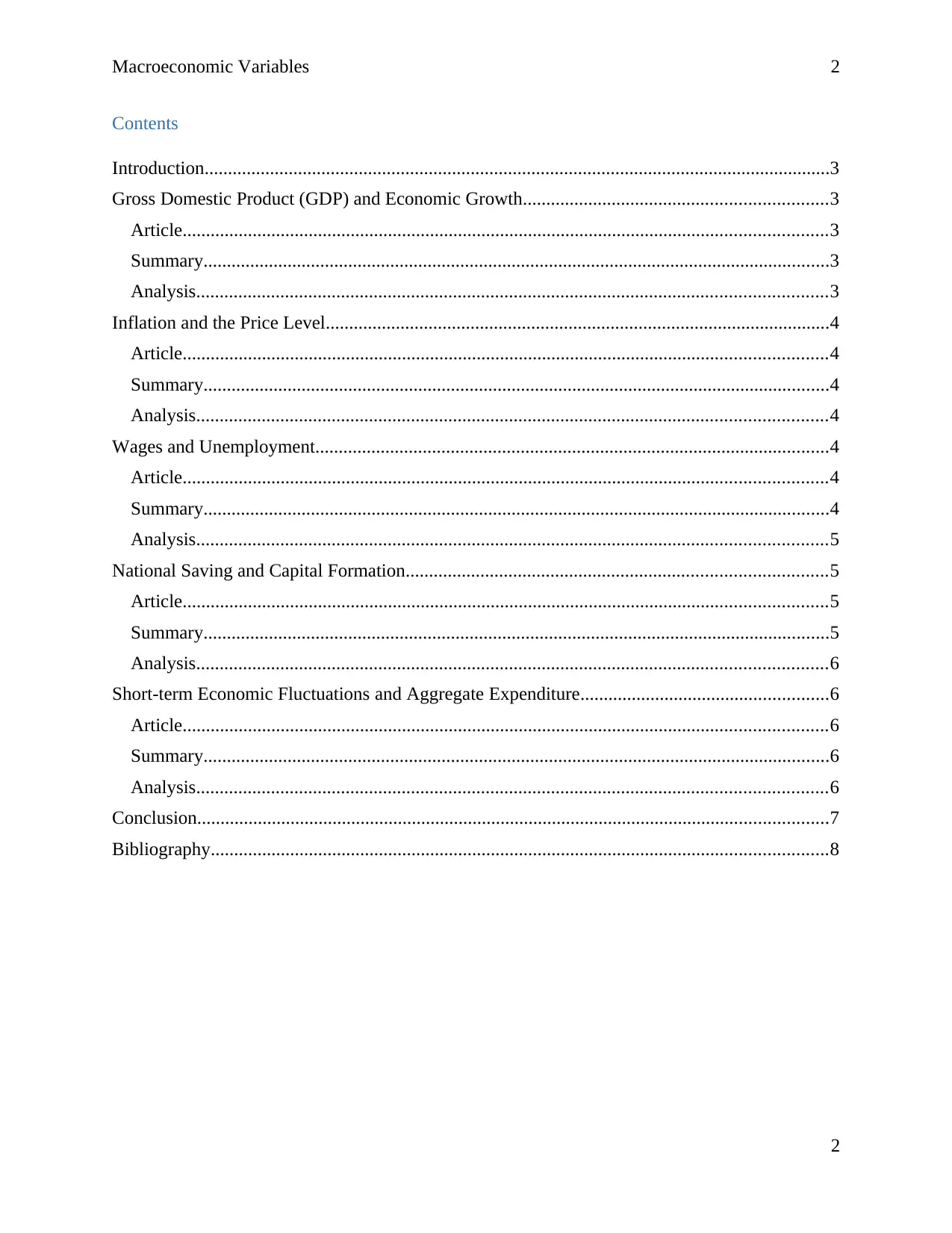
Macroeconomic Variables 2
Contents
Introduction......................................................................................................................................3
Gross Domestic Product (GDP) and Economic Growth.................................................................3
Article..........................................................................................................................................3
Summary......................................................................................................................................3
Analysis.......................................................................................................................................3
Inflation and the Price Level............................................................................................................4
Article..........................................................................................................................................4
Summary......................................................................................................................................4
Analysis.......................................................................................................................................4
Wages and Unemployment..............................................................................................................4
Article..........................................................................................................................................4
Summary......................................................................................................................................4
Analysis.......................................................................................................................................5
National Saving and Capital Formation..........................................................................................5
Article..........................................................................................................................................5
Summary......................................................................................................................................5
Analysis.......................................................................................................................................6
Short-term Economic Fluctuations and Aggregate Expenditure.....................................................6
Article..........................................................................................................................................6
Summary......................................................................................................................................6
Analysis.......................................................................................................................................6
Conclusion.......................................................................................................................................7
Bibliography....................................................................................................................................8
2
Contents
Introduction......................................................................................................................................3
Gross Domestic Product (GDP) and Economic Growth.................................................................3
Article..........................................................................................................................................3
Summary......................................................................................................................................3
Analysis.......................................................................................................................................3
Inflation and the Price Level............................................................................................................4
Article..........................................................................................................................................4
Summary......................................................................................................................................4
Analysis.......................................................................................................................................4
Wages and Unemployment..............................................................................................................4
Article..........................................................................................................................................4
Summary......................................................................................................................................4
Analysis.......................................................................................................................................5
National Saving and Capital Formation..........................................................................................5
Article..........................................................................................................................................5
Summary......................................................................................................................................5
Analysis.......................................................................................................................................6
Short-term Economic Fluctuations and Aggregate Expenditure.....................................................6
Article..........................................................................................................................................6
Summary......................................................................................................................................6
Analysis.......................................................................................................................................6
Conclusion.......................................................................................................................................7
Bibliography....................................................................................................................................8
2
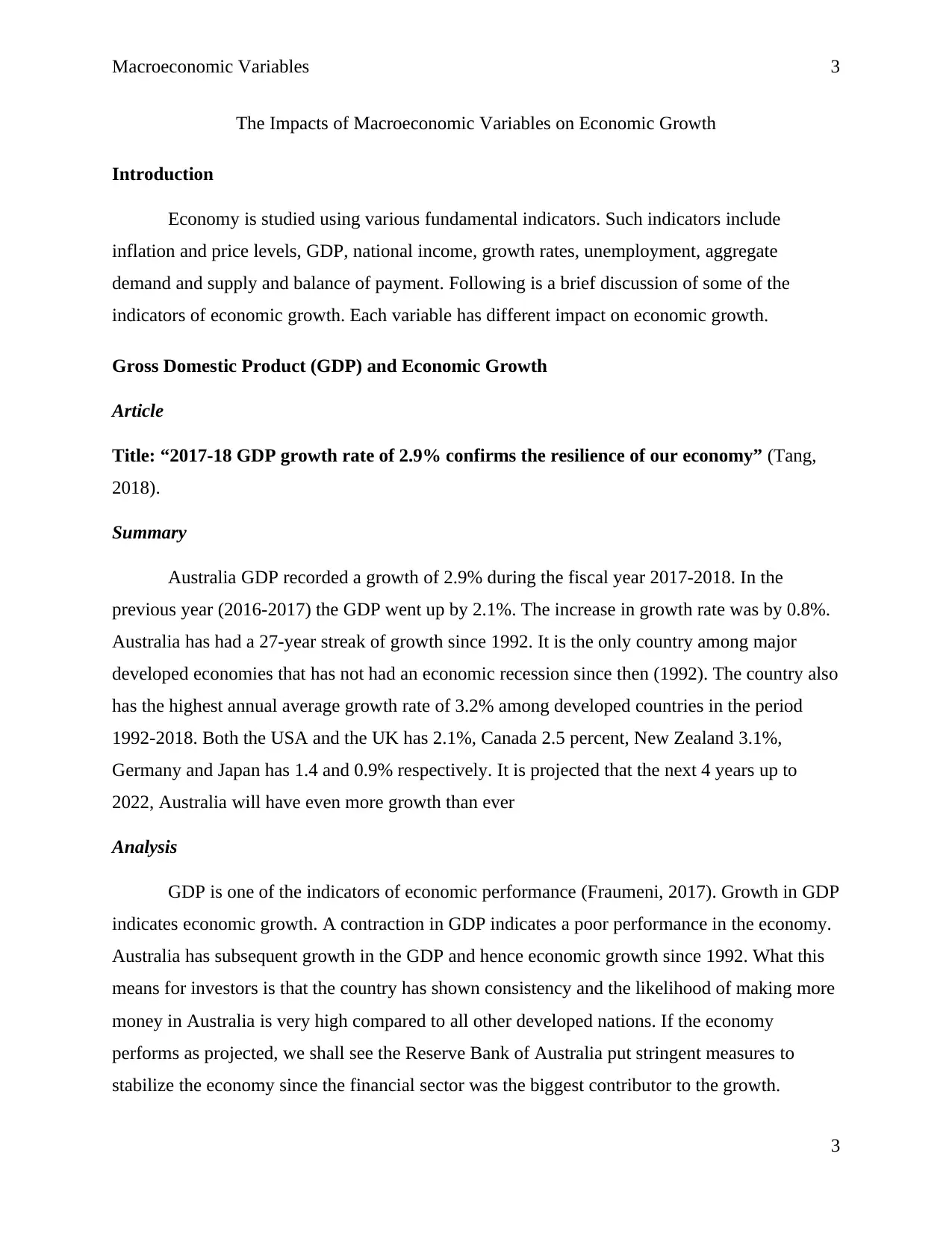
Macroeconomic Variables 3
The Impacts of Macroeconomic Variables on Economic Growth
Introduction
Economy is studied using various fundamental indicators. Such indicators include
inflation and price levels, GDP, national income, growth rates, unemployment, aggregate
demand and supply and balance of payment. Following is a brief discussion of some of the
indicators of economic growth. Each variable has different impact on economic growth.
Gross Domestic Product (GDP) and Economic Growth
Article
Title: “2017-18 GDP growth rate of 2.9% confirms the resilience of our economy” (Tang,
2018).
Summary
Australia GDP recorded a growth of 2.9% during the fiscal year 2017-2018. In the
previous year (2016-2017) the GDP went up by 2.1%. The increase in growth rate was by 0.8%.
Australia has had a 27-year streak of growth since 1992. It is the only country among major
developed economies that has not had an economic recession since then (1992). The country also
has the highest annual average growth rate of 3.2% among developed countries in the period
1992-2018. Both the USA and the UK has 2.1%, Canada 2.5 percent, New Zealand 3.1%,
Germany and Japan has 1.4 and 0.9% respectively. It is projected that the next 4 years up to
2022, Australia will have even more growth than ever
Analysis
GDP is one of the indicators of economic performance (Fraumeni, 2017). Growth in GDP
indicates economic growth. A contraction in GDP indicates a poor performance in the economy.
Australia has subsequent growth in the GDP and hence economic growth since 1992. What this
means for investors is that the country has shown consistency and the likelihood of making more
money in Australia is very high compared to all other developed nations. If the economy
performs as projected, we shall see the Reserve Bank of Australia put stringent measures to
stabilize the economy since the financial sector was the biggest contributor to the growth.
3
The Impacts of Macroeconomic Variables on Economic Growth
Introduction
Economy is studied using various fundamental indicators. Such indicators include
inflation and price levels, GDP, national income, growth rates, unemployment, aggregate
demand and supply and balance of payment. Following is a brief discussion of some of the
indicators of economic growth. Each variable has different impact on economic growth.
Gross Domestic Product (GDP) and Economic Growth
Article
Title: “2017-18 GDP growth rate of 2.9% confirms the resilience of our economy” (Tang,
2018).
Summary
Australia GDP recorded a growth of 2.9% during the fiscal year 2017-2018. In the
previous year (2016-2017) the GDP went up by 2.1%. The increase in growth rate was by 0.8%.
Australia has had a 27-year streak of growth since 1992. It is the only country among major
developed economies that has not had an economic recession since then (1992). The country also
has the highest annual average growth rate of 3.2% among developed countries in the period
1992-2018. Both the USA and the UK has 2.1%, Canada 2.5 percent, New Zealand 3.1%,
Germany and Japan has 1.4 and 0.9% respectively. It is projected that the next 4 years up to
2022, Australia will have even more growth than ever
Analysis
GDP is one of the indicators of economic performance (Fraumeni, 2017). Growth in GDP
indicates economic growth. A contraction in GDP indicates a poor performance in the economy.
Australia has subsequent growth in the GDP and hence economic growth since 1992. What this
means for investors is that the country has shown consistency and the likelihood of making more
money in Australia is very high compared to all other developed nations. If the economy
performs as projected, we shall see the Reserve Bank of Australia put stringent measures to
stabilize the economy since the financial sector was the biggest contributor to the growth.
3
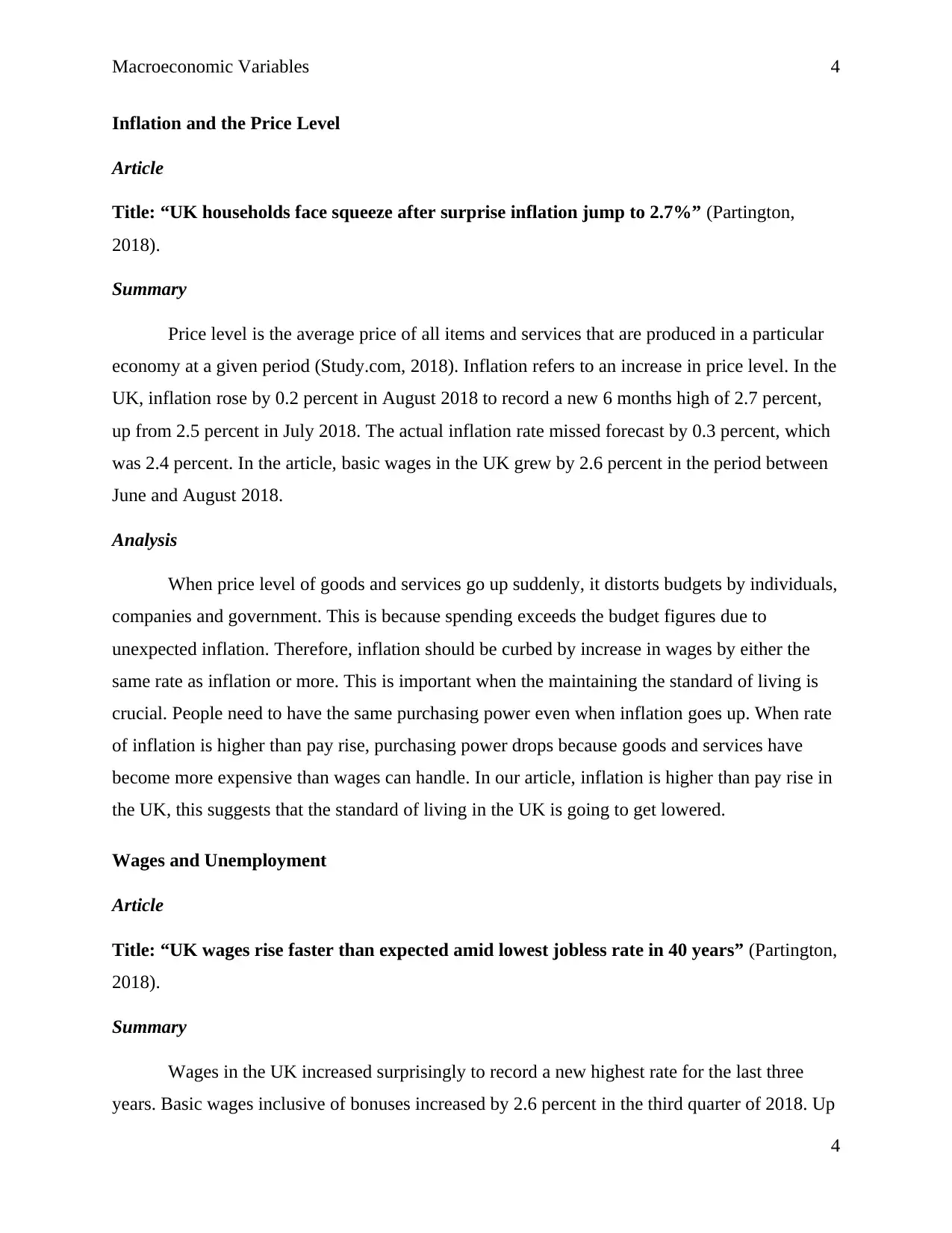
Macroeconomic Variables 4
Inflation and the Price Level
Article
Title: “UK households face squeeze after surprise inflation jump to 2.7%” (Partington,
2018).
Summary
Price level is the average price of all items and services that are produced in a particular
economy at a given period (Study.com, 2018). Inflation refers to an increase in price level. In the
UK, inflation rose by 0.2 percent in August 2018 to record a new 6 months high of 2.7 percent,
up from 2.5 percent in July 2018. The actual inflation rate missed forecast by 0.3 percent, which
was 2.4 percent. In the article, basic wages in the UK grew by 2.6 percent in the period between
June and August 2018.
Analysis
When price level of goods and services go up suddenly, it distorts budgets by individuals,
companies and government. This is because spending exceeds the budget figures due to
unexpected inflation. Therefore, inflation should be curbed by increase in wages by either the
same rate as inflation or more. This is important when the maintaining the standard of living is
crucial. People need to have the same purchasing power even when inflation goes up. When rate
of inflation is higher than pay rise, purchasing power drops because goods and services have
become more expensive than wages can handle. In our article, inflation is higher than pay rise in
the UK, this suggests that the standard of living in the UK is going to get lowered.
Wages and Unemployment
Article
Title: “UK wages rise faster than expected amid lowest jobless rate in 40 years” (Partington,
2018).
Summary
Wages in the UK increased surprisingly to record a new highest rate for the last three
years. Basic wages inclusive of bonuses increased by 2.6 percent in the third quarter of 2018. Up
4
Inflation and the Price Level
Article
Title: “UK households face squeeze after surprise inflation jump to 2.7%” (Partington,
2018).
Summary
Price level is the average price of all items and services that are produced in a particular
economy at a given period (Study.com, 2018). Inflation refers to an increase in price level. In the
UK, inflation rose by 0.2 percent in August 2018 to record a new 6 months high of 2.7 percent,
up from 2.5 percent in July 2018. The actual inflation rate missed forecast by 0.3 percent, which
was 2.4 percent. In the article, basic wages in the UK grew by 2.6 percent in the period between
June and August 2018.
Analysis
When price level of goods and services go up suddenly, it distorts budgets by individuals,
companies and government. This is because spending exceeds the budget figures due to
unexpected inflation. Therefore, inflation should be curbed by increase in wages by either the
same rate as inflation or more. This is important when the maintaining the standard of living is
crucial. People need to have the same purchasing power even when inflation goes up. When rate
of inflation is higher than pay rise, purchasing power drops because goods and services have
become more expensive than wages can handle. In our article, inflation is higher than pay rise in
the UK, this suggests that the standard of living in the UK is going to get lowered.
Wages and Unemployment
Article
Title: “UK wages rise faster than expected amid lowest jobless rate in 40 years” (Partington,
2018).
Summary
Wages in the UK increased surprisingly to record a new highest rate for the last three
years. Basic wages inclusive of bonuses increased by 2.6 percent in the third quarter of 2018. Up
4
Secure Best Marks with AI Grader
Need help grading? Try our AI Grader for instant feedback on your assignments.
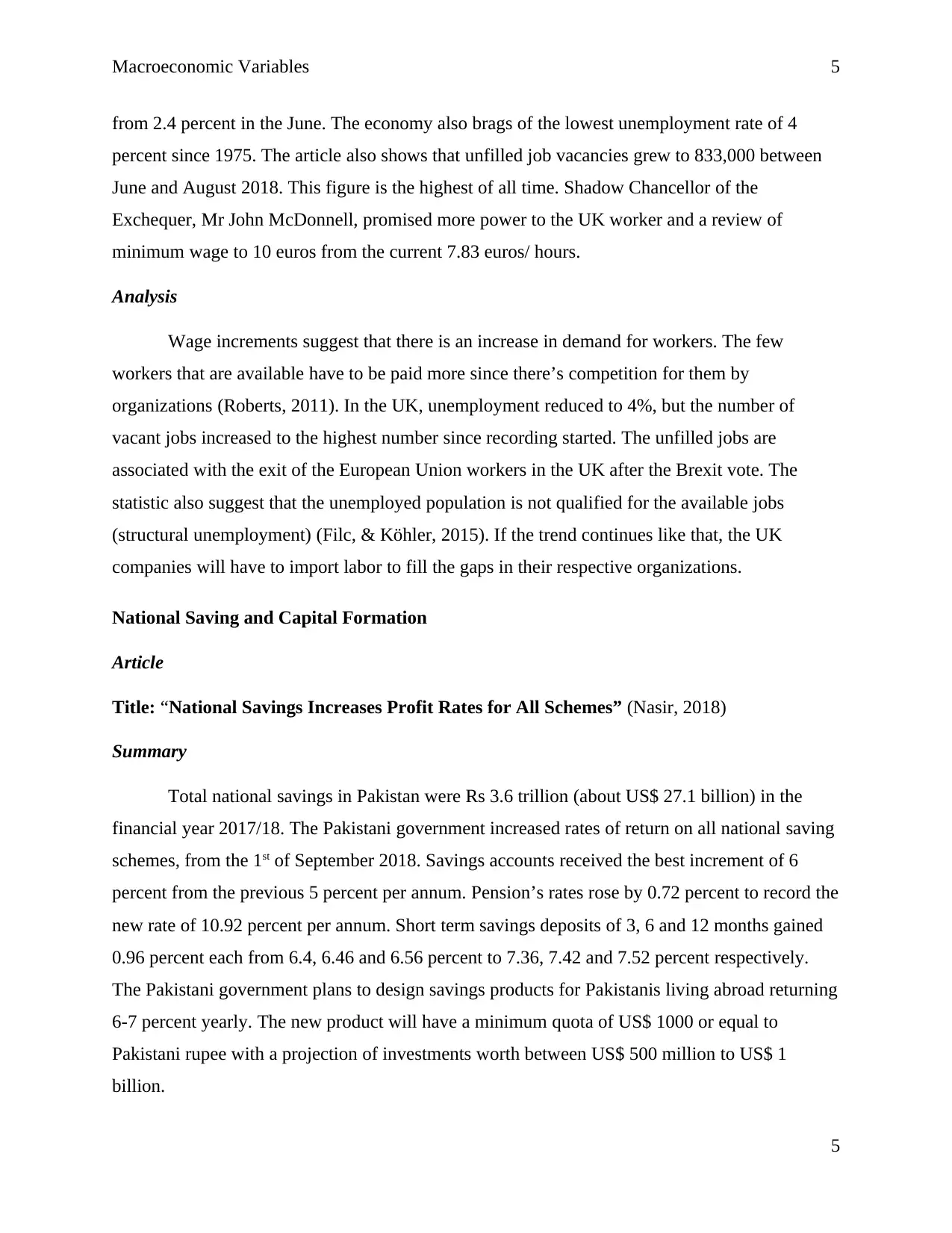
Macroeconomic Variables 5
from 2.4 percent in the June. The economy also brags of the lowest unemployment rate of 4
percent since 1975. The article also shows that unfilled job vacancies grew to 833,000 between
June and August 2018. This figure is the highest of all time. Shadow Chancellor of the
Exchequer, Mr John McDonnell, promised more power to the UK worker and a review of
minimum wage to 10 euros from the current 7.83 euros/ hours.
Analysis
Wage increments suggest that there is an increase in demand for workers. The few
workers that are available have to be paid more since there’s competition for them by
organizations (Roberts, 2011). In the UK, unemployment reduced to 4%, but the number of
vacant jobs increased to the highest number since recording started. The unfilled jobs are
associated with the exit of the European Union workers in the UK after the Brexit vote. The
statistic also suggest that the unemployed population is not qualified for the available jobs
(structural unemployment) (Filc, & Köhler, 2015). If the trend continues like that, the UK
companies will have to import labor to fill the gaps in their respective organizations.
National Saving and Capital Formation
Article
Title: “National Savings Increases Profit Rates for All Schemes” (Nasir, 2018)
Summary
Total national savings in Pakistan were Rs 3.6 trillion (about US$ 27.1 billion) in the
financial year 2017/18. The Pakistani government increased rates of return on all national saving
schemes, from the 1st of September 2018. Savings accounts received the best increment of 6
percent from the previous 5 percent per annum. Pension’s rates rose by 0.72 percent to record the
new rate of 10.92 percent per annum. Short term savings deposits of 3, 6 and 12 months gained
0.96 percent each from 6.4, 6.46 and 6.56 percent to 7.36, 7.42 and 7.52 percent respectively.
The Pakistani government plans to design savings products for Pakistanis living abroad returning
6-7 percent yearly. The new product will have a minimum quota of US$ 1000 or equal to
Pakistani rupee with a projection of investments worth between US$ 500 million to US$ 1
billion.
5
from 2.4 percent in the June. The economy also brags of the lowest unemployment rate of 4
percent since 1975. The article also shows that unfilled job vacancies grew to 833,000 between
June and August 2018. This figure is the highest of all time. Shadow Chancellor of the
Exchequer, Mr John McDonnell, promised more power to the UK worker and a review of
minimum wage to 10 euros from the current 7.83 euros/ hours.
Analysis
Wage increments suggest that there is an increase in demand for workers. The few
workers that are available have to be paid more since there’s competition for them by
organizations (Roberts, 2011). In the UK, unemployment reduced to 4%, but the number of
vacant jobs increased to the highest number since recording started. The unfilled jobs are
associated with the exit of the European Union workers in the UK after the Brexit vote. The
statistic also suggest that the unemployed population is not qualified for the available jobs
(structural unemployment) (Filc, & Köhler, 2015). If the trend continues like that, the UK
companies will have to import labor to fill the gaps in their respective organizations.
National Saving and Capital Formation
Article
Title: “National Savings Increases Profit Rates for All Schemes” (Nasir, 2018)
Summary
Total national savings in Pakistan were Rs 3.6 trillion (about US$ 27.1 billion) in the
financial year 2017/18. The Pakistani government increased rates of return on all national saving
schemes, from the 1st of September 2018. Savings accounts received the best increment of 6
percent from the previous 5 percent per annum. Pension’s rates rose by 0.72 percent to record the
new rate of 10.92 percent per annum. Short term savings deposits of 3, 6 and 12 months gained
0.96 percent each from 6.4, 6.46 and 6.56 percent to 7.36, 7.42 and 7.52 percent respectively.
The Pakistani government plans to design savings products for Pakistanis living abroad returning
6-7 percent yearly. The new product will have a minimum quota of US$ 1000 or equal to
Pakistani rupee with a projection of investments worth between US$ 500 million to US$ 1
billion.
5
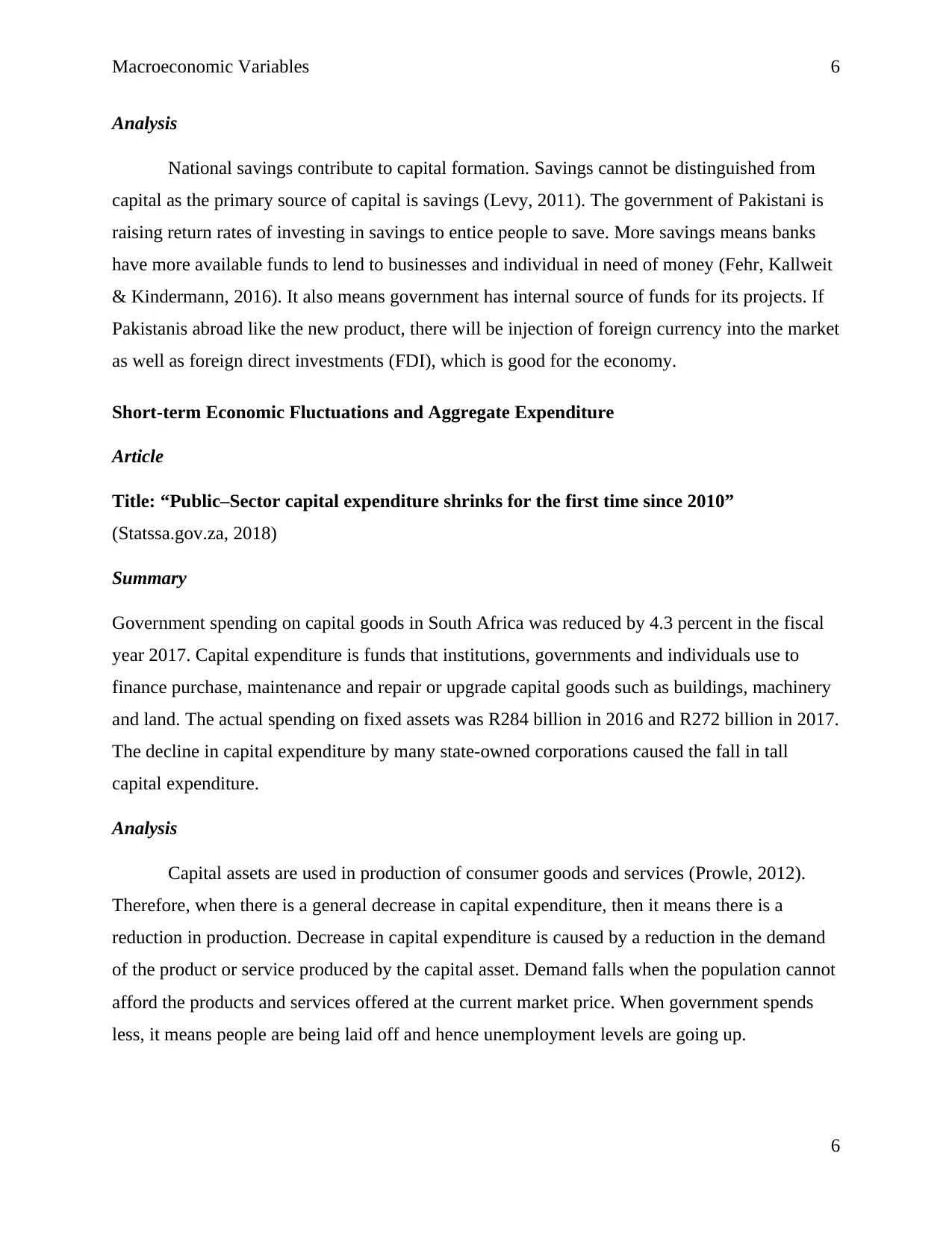
Macroeconomic Variables 6
Analysis
National savings contribute to capital formation. Savings cannot be distinguished from
capital as the primary source of capital is savings (Levy, 2011). The government of Pakistani is
raising return rates of investing in savings to entice people to save. More savings means banks
have more available funds to lend to businesses and individual in need of money (Fehr, Kallweit
& Kindermann, 2016). It also means government has internal source of funds for its projects. If
Pakistanis abroad like the new product, there will be injection of foreign currency into the market
as well as foreign direct investments (FDI), which is good for the economy.
Short-term Economic Fluctuations and Aggregate Expenditure
Article
Title: “Public–Sector capital expenditure shrinks for the first time since 2010”
(Statssa.gov.za, 2018)
Summary
Government spending on capital goods in South Africa was reduced by 4.3 percent in the fiscal
year 2017. Capital expenditure is funds that institutions, governments and individuals use to
finance purchase, maintenance and repair or upgrade capital goods such as buildings, machinery
and land. The actual spending on fixed assets was R284 billion in 2016 and R272 billion in 2017.
The decline in capital expenditure by many state-owned corporations caused the fall in tall
capital expenditure.
Analysis
Capital assets are used in production of consumer goods and services (Prowle, 2012).
Therefore, when there is a general decrease in capital expenditure, then it means there is a
reduction in production. Decrease in capital expenditure is caused by a reduction in the demand
of the product or service produced by the capital asset. Demand falls when the population cannot
afford the products and services offered at the current market price. When government spends
less, it means people are being laid off and hence unemployment levels are going up.
6
Analysis
National savings contribute to capital formation. Savings cannot be distinguished from
capital as the primary source of capital is savings (Levy, 2011). The government of Pakistani is
raising return rates of investing in savings to entice people to save. More savings means banks
have more available funds to lend to businesses and individual in need of money (Fehr, Kallweit
& Kindermann, 2016). It also means government has internal source of funds for its projects. If
Pakistanis abroad like the new product, there will be injection of foreign currency into the market
as well as foreign direct investments (FDI), which is good for the economy.
Short-term Economic Fluctuations and Aggregate Expenditure
Article
Title: “Public–Sector capital expenditure shrinks for the first time since 2010”
(Statssa.gov.za, 2018)
Summary
Government spending on capital goods in South Africa was reduced by 4.3 percent in the fiscal
year 2017. Capital expenditure is funds that institutions, governments and individuals use to
finance purchase, maintenance and repair or upgrade capital goods such as buildings, machinery
and land. The actual spending on fixed assets was R284 billion in 2016 and R272 billion in 2017.
The decline in capital expenditure by many state-owned corporations caused the fall in tall
capital expenditure.
Analysis
Capital assets are used in production of consumer goods and services (Prowle, 2012).
Therefore, when there is a general decrease in capital expenditure, then it means there is a
reduction in production. Decrease in capital expenditure is caused by a reduction in the demand
of the product or service produced by the capital asset. Demand falls when the population cannot
afford the products and services offered at the current market price. When government spends
less, it means people are being laid off and hence unemployment levels are going up.
6
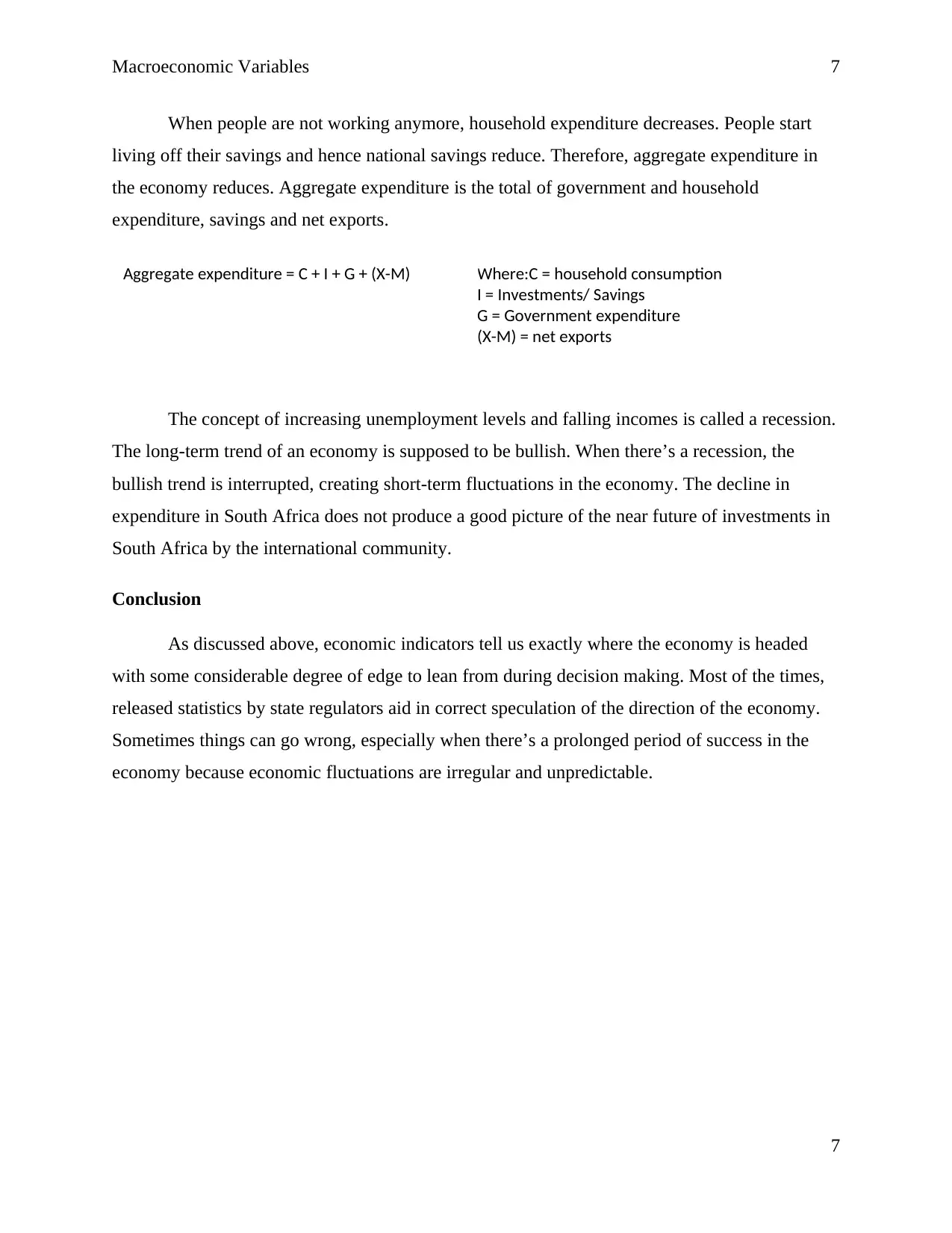
Macroeconomic Variables 7
When people are not working anymore, household expenditure decreases. People start
living off their savings and hence national savings reduce. Therefore, aggregate expenditure in
the economy reduces. Aggregate expenditure is the total of government and household
expenditure, savings and net exports.
The concept of increasing unemployment levels and falling incomes is called a recession.
The long-term trend of an economy is supposed to be bullish. When there’s a recession, the
bullish trend is interrupted, creating short-term fluctuations in the economy. The decline in
expenditure in South Africa does not produce a good picture of the near future of investments in
South Africa by the international community.
Conclusion
As discussed above, economic indicators tell us exactly where the economy is headed
with some considerable degree of edge to lean from during decision making. Most of the times,
released statistics by state regulators aid in correct speculation of the direction of the economy.
Sometimes things can go wrong, especially when there’s a prolonged period of success in the
economy because economic fluctuations are irregular and unpredictable.
7
Where:C = household consumption
I = Investments/ Savings
G = Government expenditure
(X-M) = net exports
Aggregate expenditure = C + I + G + (X-M)
When people are not working anymore, household expenditure decreases. People start
living off their savings and hence national savings reduce. Therefore, aggregate expenditure in
the economy reduces. Aggregate expenditure is the total of government and household
expenditure, savings and net exports.
The concept of increasing unemployment levels and falling incomes is called a recession.
The long-term trend of an economy is supposed to be bullish. When there’s a recession, the
bullish trend is interrupted, creating short-term fluctuations in the economy. The decline in
expenditure in South Africa does not produce a good picture of the near future of investments in
South Africa by the international community.
Conclusion
As discussed above, economic indicators tell us exactly where the economy is headed
with some considerable degree of edge to lean from during decision making. Most of the times,
released statistics by state regulators aid in correct speculation of the direction of the economy.
Sometimes things can go wrong, especially when there’s a prolonged period of success in the
economy because economic fluctuations are irregular and unpredictable.
7
Where:C = household consumption
I = Investments/ Savings
G = Government expenditure
(X-M) = net exports
Aggregate expenditure = C + I + G + (X-M)
Paraphrase This Document
Need a fresh take? Get an instant paraphrase of this document with our AI Paraphraser
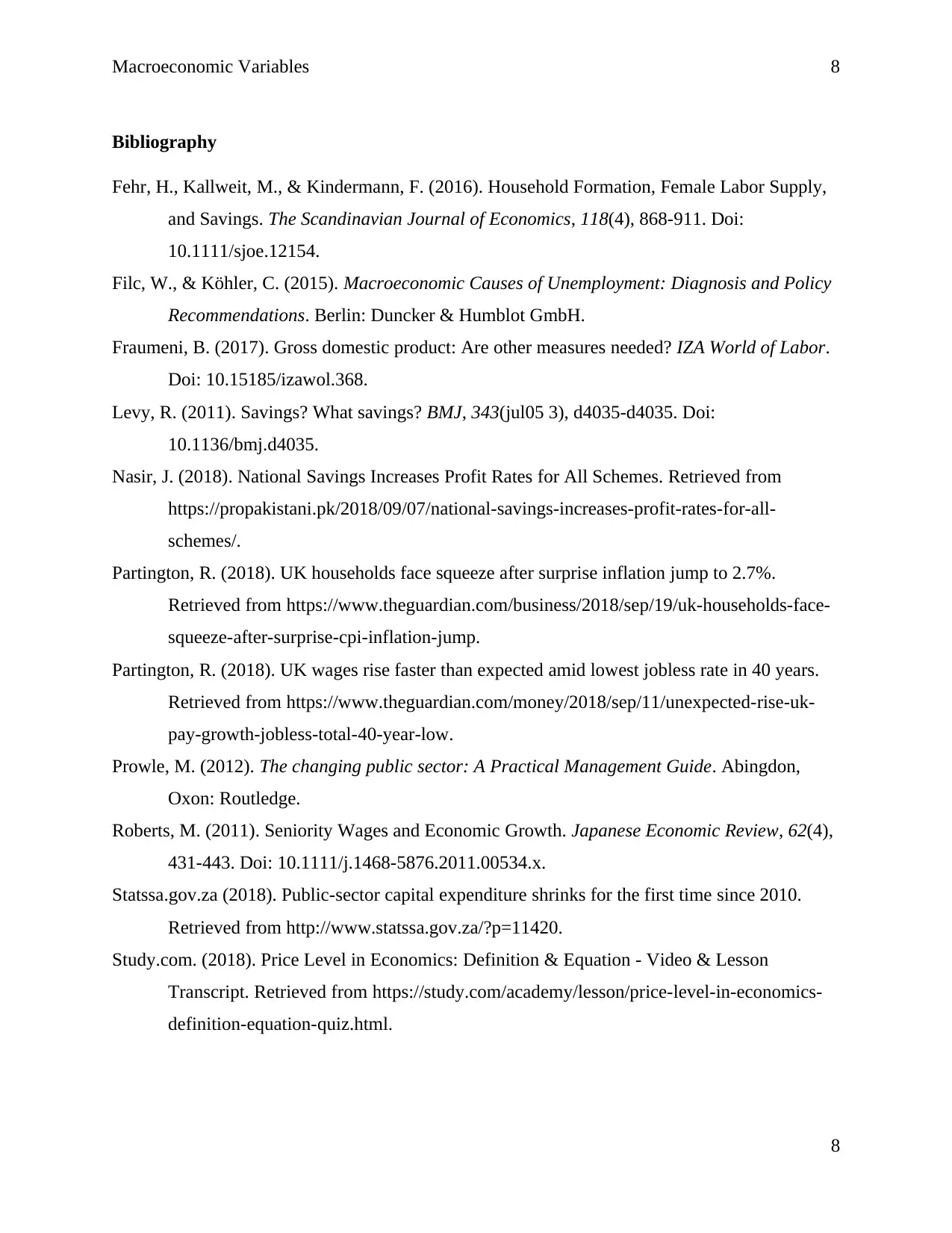
Macroeconomic Variables 8
Bibliography
Fehr, H., Kallweit, M., & Kindermann, F. (2016). Household Formation, Female Labor Supply,
and Savings. The Scandinavian Journal of Economics, 118(4), 868-911. Doi:
10.1111/sjoe.12154.
Filc, W., & Köhler, C. (2015). Macroeconomic Causes of Unemployment: Diagnosis and Policy
Recommendations. Berlin: Duncker & Humblot GmbH.
Fraumeni, B. (2017). Gross domestic product: Are other measures needed? IZA World of Labor.
Doi: 10.15185/izawol.368.
Levy, R. (2011). Savings? What savings? BMJ, 343(jul05 3), d4035-d4035. Doi:
10.1136/bmj.d4035.
Nasir, J. (2018). National Savings Increases Profit Rates for All Schemes. Retrieved from
https://propakistani.pk/2018/09/07/national-savings-increases-profit-rates-for-all-
schemes/.
Partington, R. (2018). UK households face squeeze after surprise inflation jump to 2.7%.
Retrieved from https://www.theguardian.com/business/2018/sep/19/uk-households-face-
squeeze-after-surprise-cpi-inflation-jump.
Partington, R. (2018). UK wages rise faster than expected amid lowest jobless rate in 40 years.
Retrieved from https://www.theguardian.com/money/2018/sep/11/unexpected-rise-uk-
pay-growth-jobless-total-40-year-low.
Prowle, M. (2012). The changing public sector: A Practical Management Guide. Abingdon,
Oxon: Routledge.
Roberts, M. (2011). Seniority Wages and Economic Growth. Japanese Economic Review, 62(4),
431-443. Doi: 10.1111/j.1468-5876.2011.00534.x.
Statssa.gov.za (2018). Public-sector capital expenditure shrinks for the first time since 2010.
Retrieved from http://www.statssa.gov.za/?p=11420.
Study.com. (2018). Price Level in Economics: Definition & Equation - Video & Lesson
Transcript. Retrieved from https://study.com/academy/lesson/price-level-in-economics-
definition-equation-quiz.html.
8
Bibliography
Fehr, H., Kallweit, M., & Kindermann, F. (2016). Household Formation, Female Labor Supply,
and Savings. The Scandinavian Journal of Economics, 118(4), 868-911. Doi:
10.1111/sjoe.12154.
Filc, W., & Köhler, C. (2015). Macroeconomic Causes of Unemployment: Diagnosis and Policy
Recommendations. Berlin: Duncker & Humblot GmbH.
Fraumeni, B. (2017). Gross domestic product: Are other measures needed? IZA World of Labor.
Doi: 10.15185/izawol.368.
Levy, R. (2011). Savings? What savings? BMJ, 343(jul05 3), d4035-d4035. Doi:
10.1136/bmj.d4035.
Nasir, J. (2018). National Savings Increases Profit Rates for All Schemes. Retrieved from
https://propakistani.pk/2018/09/07/national-savings-increases-profit-rates-for-all-
schemes/.
Partington, R. (2018). UK households face squeeze after surprise inflation jump to 2.7%.
Retrieved from https://www.theguardian.com/business/2018/sep/19/uk-households-face-
squeeze-after-surprise-cpi-inflation-jump.
Partington, R. (2018). UK wages rise faster than expected amid lowest jobless rate in 40 years.
Retrieved from https://www.theguardian.com/money/2018/sep/11/unexpected-rise-uk-
pay-growth-jobless-total-40-year-low.
Prowle, M. (2012). The changing public sector: A Practical Management Guide. Abingdon,
Oxon: Routledge.
Roberts, M. (2011). Seniority Wages and Economic Growth. Japanese Economic Review, 62(4),
431-443. Doi: 10.1111/j.1468-5876.2011.00534.x.
Statssa.gov.za (2018). Public-sector capital expenditure shrinks for the first time since 2010.
Retrieved from http://www.statssa.gov.za/?p=11420.
Study.com. (2018). Price Level in Economics: Definition & Equation - Video & Lesson
Transcript. Retrieved from https://study.com/academy/lesson/price-level-in-economics-
definition-equation-quiz.html.
8
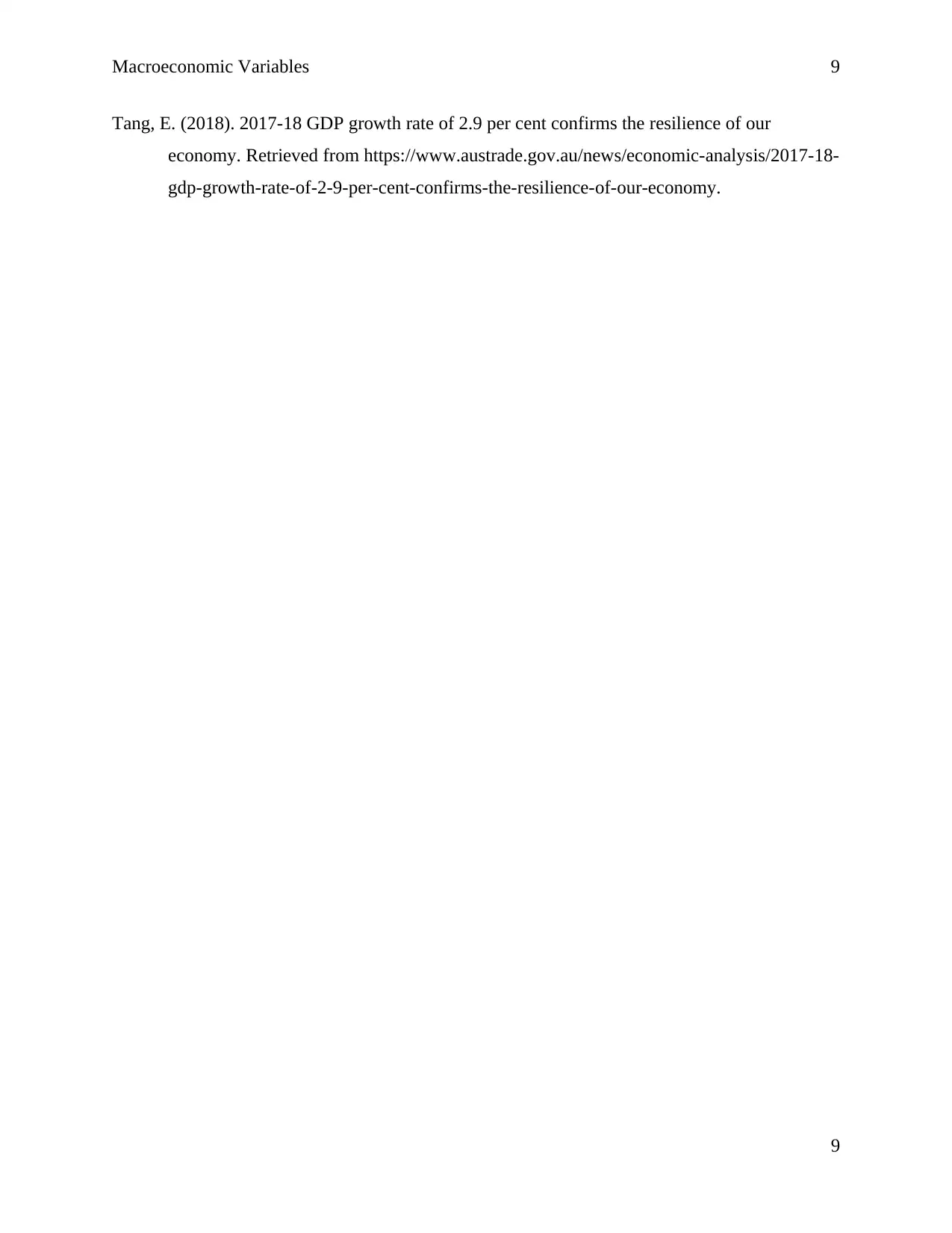
Macroeconomic Variables 9
Tang, E. (2018). 2017-18 GDP growth rate of 2.9 per cent confirms the resilience of our
economy. Retrieved from https://www.austrade.gov.au/news/economic-analysis/2017-18-
gdp-growth-rate-of-2-9-per-cent-confirms-the-resilience-of-our-economy.
9
Tang, E. (2018). 2017-18 GDP growth rate of 2.9 per cent confirms the resilience of our
economy. Retrieved from https://www.austrade.gov.au/news/economic-analysis/2017-18-
gdp-growth-rate-of-2-9-per-cent-confirms-the-resilience-of-our-economy.
9
1 out of 9
Related Documents
Your All-in-One AI-Powered Toolkit for Academic Success.
+13062052269
info@desklib.com
Available 24*7 on WhatsApp / Email
![[object Object]](/_next/static/media/star-bottom.7253800d.svg)
Unlock your academic potential
© 2024 | Zucol Services PVT LTD | All rights reserved.




